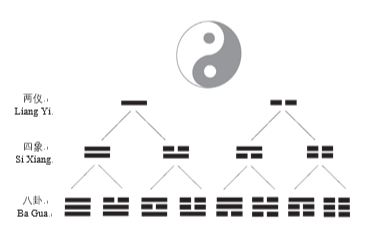Zhou Yi (Changes of Zhou)
Zhou Yi is one of the classics of pre-Qin China, composed of Yi Jing (the Book of Changes) and Yi Zhuan (the Commentary to the Book of Changes, also called the 'Ten Wings'). Yi Jing is composed of graphics and texts: The graphics contain 64 Gua (hexagrams) and 384 Yao (6 lines per hexagram), and the texts are called Gua Ci and Yao Ci, which are descriptions of hexagrams and lines respectively. Yi Zhuan is a collection of ten pieces, comprising seven explanations and commentaries of the Gua and Yao, and it was known as "Ten Wings" (Wing means assistance).
Zhou Yi was originally a divination manual in the Zhou Dynasty (c. 1046-256 B.C.). According to Zhou Yi, yin and yang are the basic aspects of everything in the universe. The solid line "-" stands for the yang, and the broken line "- -" stands for the yin, together they are called Liang Yi (the two modes). The two modes generate the four images, and the four images give birth to the eight trigrams. The overlapping of the two modes forms Si Xiang (the four images). Different combinations of the yang and/or yin lines (unbroken and broken lines) give rise to Ba Gua or the eight trigrams (Qian☰, Kun☷, Kan☵, Li☲, Zhen☳, Gen☶, Xun☴, Dui☱), which represent eight basic natural phenomena (Qian for sky or heaven, Kun for ground or earth, Kan for water, Li for fire, Zhen for thunder, Gen for mountain, Xun for wind, and Dui for lake or marsh). Different combinations of the eight trigrams form 64 hexagrams, which can encompass all phenomena and their changes in nature and human society.
Zhou Yi reflects the ancient Chinese understanding of the universe - the universe is in a constant state of change, and as are the essence of the universe, change alone is eternal. Zhou Yi stands for the perception and the utilization of such constant change. This recognition and understanding of changes, or rather an attempt at explaining the mysteries of everything in the universe, places Zhou Yi at the top of all ancient classics.
A philosophical masterpiece of ancient China, Zhou Yi provides a theoretical framework for all studies in natural philosophy and social practices, embodying the wisdom and spirit of the Chinese nation. Later scholars made multiple attempts to interpret Zhou Yi, giving rise to a wealth of studies on this book with a profound impact on various aspects of political, economic, and cultural life in ancient China. The philosophical thinking elucidated in this book and related interpretation attempts informs the wisdom and spirit of the Chinese nation. It encourages self-improvement and extols moral strength. These ideas continue to nourish the spirit of contemporary China.

《周易》
《周易》是中国先秦时期的传统典籍,包括经和传两部分。其中,《易经》分为图像和文字两部分,图像部分是64 卦和384爻,文字部分称为卦辞、爻辞,是对卦、爻的说明。后续有解释和阐发卦辞和爻辞的作品《易传》,包括7种文辞共10篇,统称“十翼”(“翼”为辅助之义)。
《周易》原本是周代人卜筮所用的书。《周易》认为,宇宙万物均由阴、阳两个基本方面构成,以阳爻(—)和阴爻(- -)两种基本符号表示,称为两仪。两仪生四象,四象生八卦,两仪分别重叠,形成四象,四象再加阴阳爻,即阳爻和阴爻经三次重叠形成八卦(见图),八卦代表着自然界的八种现象。八卦相互重叠形成六十四卦,可以囊括自然界和人类社会的一切现象及其变化。
《周易》反映了中国古人对宇宙的认识,即宇宙始终处于变化之中,变化是宇宙的本质,只有变化才是永恒的。《周易》实际上就是对变化的认识和把握,被认为蕴含了宇宙万事万物的奥秘,在中国古代被誉为“群经之首”“大道之源”。
《周易》是中国古代杰出的哲学巨著,是中国传统思想文化中自然哲学与人文实践的理论根源,是中华民族智慧和精神的结晶。《周易》经过后世学者的不断阐释,形成了蔚为大观的“易学”,对中国几千年来政治、经济、文化等都产生了极其深刻的影响,其中蕴含的自强不息、厚德载物等内容成为滋养当代中国精神的重要源泉。
